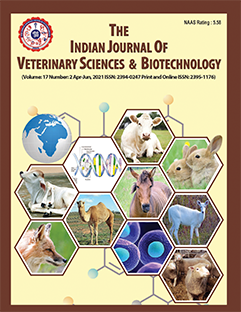Surgical Management of Dystocia due to Fetal Monster in Dumba Sheep
DOI:
https://doi.org/10.48165/ijvsbt.21.4.38Keywords:
Dystocia, prolonged, unassisted, interventionAbstract
Dystocia refers to a difficult birth characterized by prolonged, unassisted labour or a delivery that requires intervention (Zaborski et al., 2009). In small ruminants, dystocia occurs less frequently than in large ruminants, with an incidence of less than 5% (Brounts et al., 2004; Bhattacharyya et al., 2015). The most common cause of dystocia in a primiparous ewe carrying a single male lamb is feto-maternal disproportion (Jackson, 2004). The relative frequency of the various fetal causes and various types of malpresentation has also been shown to vary between breeds (Dwyer and Bunger, 2012). It typically arises when the first or second stage of parturition is delayed. Most common causes of dystocia are classified in two categories, viz., maternal and fetal origin. Fetal dystocia occurs mainly due to faulty disposition (presentation, position, and posture), congenital monsters, and foetal pathological condition like ascites and emphysema. Maternal causes of dystocia mainly include uterine inertia, weak abdominal straining, incomplete dilation or constriction of birth canal and inadequate pelvis (David et al., 2019). Many authors reported that Caesarean section can be considered an effective way for treatment of dystocia in sheep, especially when performed early after the onset of the signs of parturition (Khan et al., 2018; Bruce et al., 2021). The present case describes the successful surgical management of dystocia due to foetal monster in a Dumba sheep.
Downloads
References
Bhattacharyya, H.K., Bhat, F.A., & Buchoo, B.A. (2015). Prevalence of dystocia in sheep and goats: A study of 70 cases (2004–2011). Journal of Advanced Veterinary Research, 5(1), 14–20.
Brounts, S.H., Hawkins, J.F., Baird, A.N., & Glickman, L.T. (2004). Outcome and subsequent fertility of sheep and goats undergoing Caesarean section because of dystocia: 110 cases (1981–2001). Journal of the American Veterinary Medical Association, 224(2), 275–281.
Bruce, M., Young, J.M., Masters, D.G., Refshauge, G., Thompson, A.N., Kenyon, P.R., Behrendt, R., Lockwood, A., Miller, D.W., & Jacobson, C. (2021). The impact of lamb and ewe mortality associated with dystocia on Australian and New Zealand sheep farms: A systematic review, meta-analysis and bio-economic model. Preventive Veterinary Medicine, 196, 105478.
David, E.N., Timothy, J.P., & Gary, C.W.E. (2019). Veterinary Reproduction and Obstetrics (10th ed., pp. 212–220). Saunders, Elsevier.
Dwyer, C.M., & Bunger, L. (2012). Factors affecting dystocia and offspring vigour in different sheep genotypes. Preventive Veterinary Medicine, 103(4), 257–264.
Jackson, P.G.G. (2004). Handbook of Veterinary Obstetrics (2nd ed., pp. 105–124). Saunders, Elsevier Missouri.
Khan, S., Satheesh, A., Sabarinadh, V.R., Ranjith Mohan, M., Sidhique, S.A., & Panikkassery, S. (2018). Surgical management of dystocia due to uterine adhesion in a goat. Journal of Entomology & Zoological Studies, 6(6), 988–991.
Mchugh, N., Berry, D.P., & Pabiou, T. (2016). Risk factor associated with lambing traits. Animal, 10(1), 89–95.
Zaborski, D., Grzesiak, W., Szatkowska, I., Dybus, A., Muszynska, M., & Jedrzejczak, M. (2009). Factors affecting dystocia in cattle. Reproduction in Domestic Animals, 44(3), 540–551.
Zerihun, M., & Dese, K. (2022). Surgical management of dystocia in local breed sheep: A case series. Veterinary Medical Open Journal, 7(2), 38–41.
Downloads
Published
Issue
Section
License
Copyright (c) 2025 Indian Journal of Veterinary Sciences and Biotechnology

This work is licensed under a Creative Commons Attribution-NonCommercial-NoDerivatives 4.0 International License.




